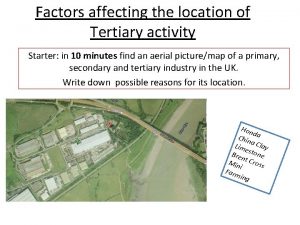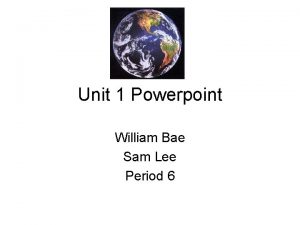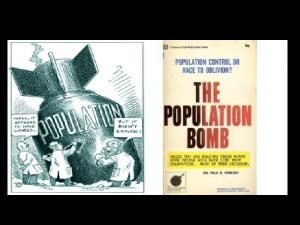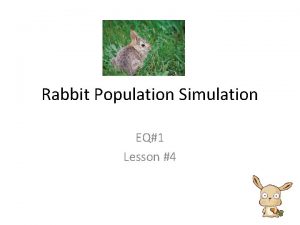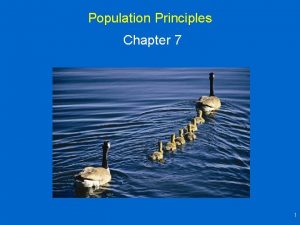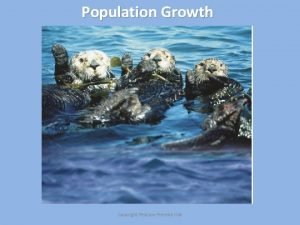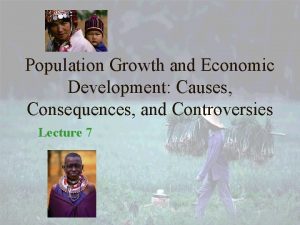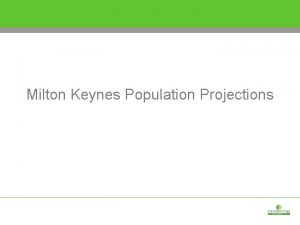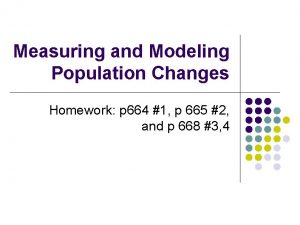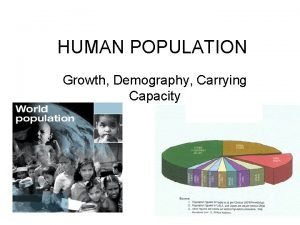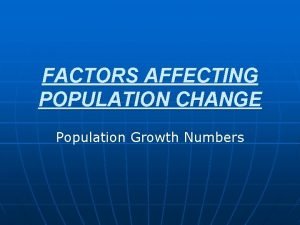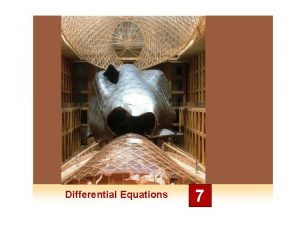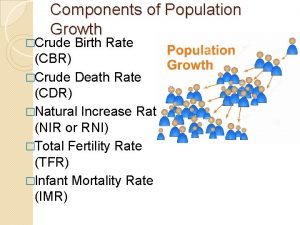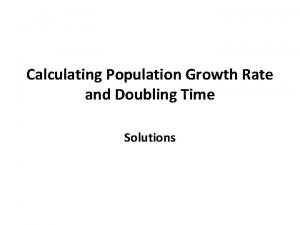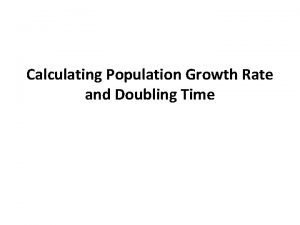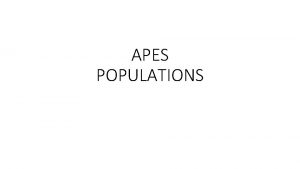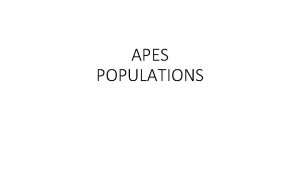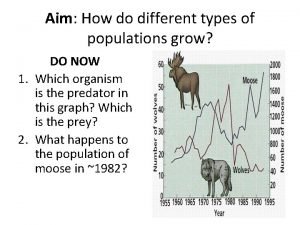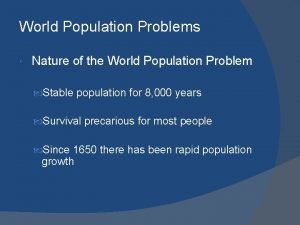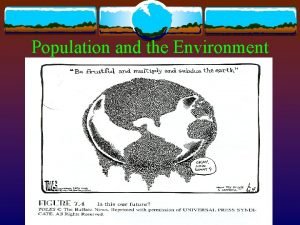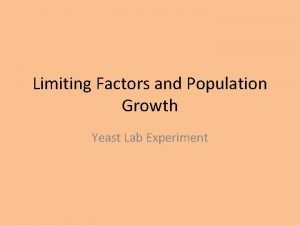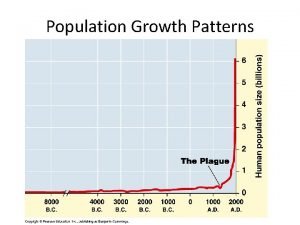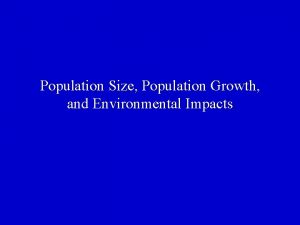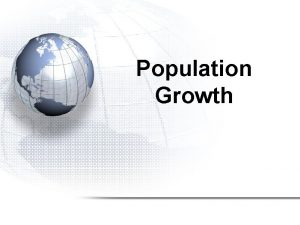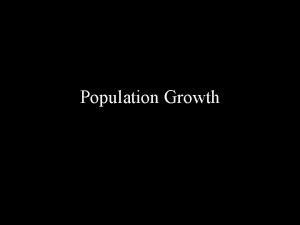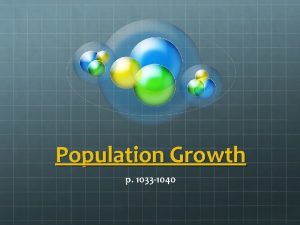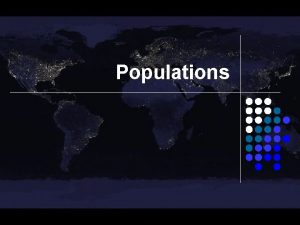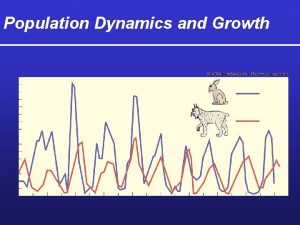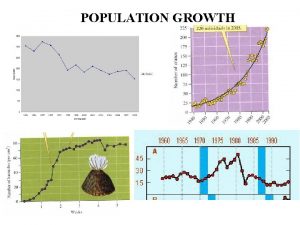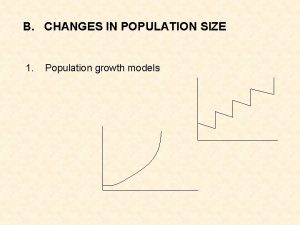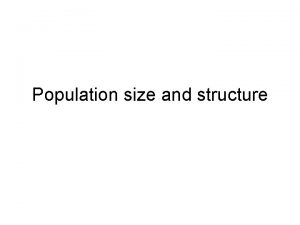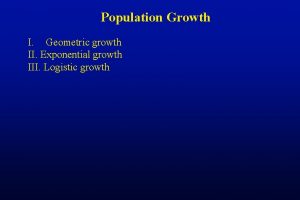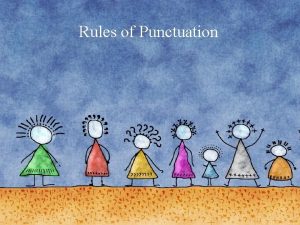Population growth What affects population size Starting activity



































- Slides: 35

Population growth What affects population size?

Starting activity: Come up with a definition for the following • Population size • Population density


Lesson objectives: Pupils will be able to. . . • Explain the significance of limiting factors in determining the final size of a population; • Explain the meaning of the term carrying capacity; • Explain, with examples, the terms interspecific and intraspecific competition;

Population growth Algal cell capable of asexual reproduction • List as many reasons as you can as to why its population would stop growing? Very hard to investigate in a natural open environment like a pond. . so we don’t! In a lab, bacteria can be grown in a nutrient medium kept under constant conditions.

r/K selection theory of population growth Selective pressures drive evolution in one of two generalized directions: • Either r- or K-selection. • r refers to reproductive rate • K refers to a constant

Logistic growth curve (k-Strategists) Carrying capacity

Population size Boom and bust (r-Strategists) K Carrying capacity ‘Bust’ ‘Boom’ Time

r-strategists examples – Typically, r-selected species exploit less-crowded ecological niches, and produce many offspring, each of which has a relatively low probability of surviving to adulthood. – Organisms with r-selected traits range from; – Bacteria. – Diatoms. – Micro fungi (Penicillium, Yeast). – Insects. – Weeds. – Various cephalopods e. g. Squid. – Some mammals, especially small rodents.

r- and K-strategists In ecological succession • r- strategists prosper at first, as the environment is unstable, however, as species settle the environment begins to become more stable and K- strategists take control.

r- and K-strategists In ecological succession • In areas of major ecological disruption or sterilisation (such as after a major volcanic eruption, as at Krakatoa or Mount Saint Helens), r - and K-strategists play distinct roles in the ecological succession that regenerates the ecosystem. • Because of their higher reproductive rates and ecological opportunism, primary colonisers typically are r-strategists and they are followed by a succession of increasingly competitive flora and fauna.

r- and K-strategists In ecological succession • Eventually a new equilibrium is approached (sometimes referred to as a climax community), with r-strategists gradually being replaced by Kstrategists which are more competitive and better adapted to the emerging micro-environmental characteristics of the landscape.

Human Population Growth Are humans r- or Kstrategists? Why? Where is the human population on its typical growth curve? Is there any reason to believe that we will not experience the “standard” pattern?

Limiting factors and carrying capacity • Limiting factors are collectively called Environmental resistance • Carrying capacity = maximum population size that can be maintained over a period of time in a particular habitat and resources available Density dependent (biotic) Limiting factors Density independent (abiotic)

Limiting factors affect population by influencing. . . . What factors? 1. 2. 3. 4. Birth rate (natality) Death rate (mortality) Immigration Emigration

What will influence the carrying capacity? Make a table and list as many factors as you can that would. . . • Increase the carrying capacity • Decrease the carrying capacity Discuss your ideas with your neighbour!

Checking understanding. . . • Explain the connection between carrying capacity and limiting factors Homework:

B C D A



Competition

What’s the difference. . • Intraspecific competition • Interspecific competition Give some examples of each.

Mallards fighting for mates

Inter-specific competition Example 1 - Paramecium P. caudatum P. aurelia

Interspecific competition & competitive exclusion principle 1934, Russian Biologist Carl Fredrick Gausse Competitive exclusion principle: no two species can occupy the same niche indefinitely when resources are limiting.

Growth curves of two Paramecium species

Inter-specific competition affects: 1. Size of two populations • When grown separately, populations of P. caudatum and P. bursaria are three times denser than when grown together

2. Distribution of two populations • P. caudatum survived towards top of tube - better adapted to feed on bacteria - more oxygen at top so more bacteria • P. bursaria survived towards bottom of tube - better adapted to feed on yeast - less oxygen = bacterial growth not favoured, more yeast survive

Shag - Phalacrocorax aristotelis Cormorant Phalacrocorax carbo • Mixed diet, sand eels and herring • Eats mostly flat fish, gobies and shrimps • Fishes in shallow estuaries • Fishes out to sea • Nests low on cliffs or shallow ledges • Nests on high cliffs or broad ledges

Shag Cormorant

Extinction of one population is not necessarily inevitable. . . • Interspecific competition could result in two populations, one being much smaller than the other, both remaining constant. • Other variables will take effect, environmental factors, for example.

Population distribution What can you explain from this diagram?

Acorn barnacle - Chthamalus • Able to live both low down and high up on shore • Smaller in size

Crenate barnacle - Balanus • Only survives lower down shore as not well adapted to tolerate exposure to air at low tide • Larger in size

Tasks: 1. Complete worksheet on barnacles. 2. Complete question sheet on competition 3. Complete competition exam question (Jan 05 Q 4) Finish all above tasks for homework
 Thinking language and intelligence
Thinking language and intelligence A factor that affects tertiary activity
A factor that affects tertiary activity Plant growth index
Plant growth index Monocots vs eudicots
Monocots vs eudicots Carothers equation
Carothers equation Primary growth and secondary growth in plants
Primary growth and secondary growth in plants Vascular ray
Vascular ray Geometric vs exponential growth
Geometric vs exponential growth Neoclassical growth theory vs. endogenous growth theory
Neoclassical growth theory vs. endogenous growth theory Organic growth vs inorganic growth
Organic growth vs inorganic growth Rule of 70
Rule of 70 What are the two types of population growth
What are the two types of population growth Modeling population growth rabbits answer key
Modeling population growth rabbits answer key Survivorship curve
Survivorship curve Population growth factors
Population growth factors Why population growth is good
Why population growth is good What is population ecology
What is population ecology Logistic growth equation population ecology
Logistic growth equation population ecology Population of milton keynes 2021
Population of milton keynes 2021 Types of population growth
Types of population growth Tragedy of the commons
Tragedy of the commons Pre reproductive age
Pre reproductive age Population growth factors
Population growth factors Population growth differential equation
Population growth differential equation Birth rate decline
Birth rate decline Unalaska ak population pyramid
Unalaska ak population pyramid Logistic model of population growth
Logistic model of population growth Doubling time calculator
Doubling time calculator Cbr-cdr/10
Cbr-cdr/10 Logistic growth model apes definition
Logistic growth model apes definition Rule of 70 in population growth
Rule of 70 in population growth What are the two types of population growth
What are the two types of population growth Importance of population growth
Importance of population growth World population by age
World population by age Arithmetically vs geometrically growth
Arithmetically vs geometrically growth Yeast population growth lab
Yeast population growth lab

